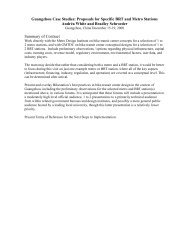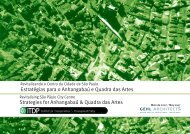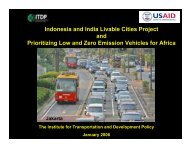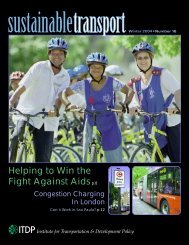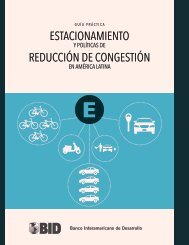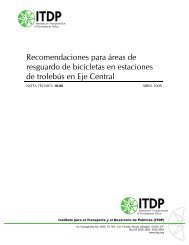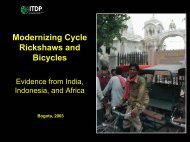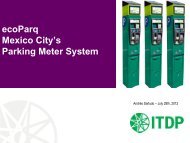Annual Report - ITDP | Institute for Transportation and Development ...
Annual Report - ITDP | Institute for Transportation and Development ...
Annual Report - ITDP | Institute for Transportation and Development ...
Create successful ePaper yourself
Turn your PDF publications into a flip-book with our unique Google optimized e-Paper software.
Letter from the Executive Director<br />
By Walter Hook<br />
2011, perhaps more than any other time<br />
in <strong>ITDP</strong>’s history, has seen momentum <strong>for</strong><br />
positive change building significantly. Our<br />
past work is bearing real fruit, <strong>and</strong> the<br />
impact is exponential. Dem<strong>and</strong> among cities<br />
around the world <strong>for</strong> <strong>ITDP</strong>’s involvement<br />
<strong>and</strong> expertise is higher than ever.<br />
In every city where <strong>ITDP</strong> works, we aim<br />
<strong>for</strong> trans<strong>for</strong>mative change that will inspire<br />
<strong>and</strong> capture the imagination of other city<br />
leaders <strong>and</strong> residents <strong>and</strong> encourage them<br />
to follow suit. As a result of this approach,<br />
<strong>ITDP</strong> has achieved several successful transport<br />
projects in just the past few years that<br />
we are able to use as models to inspire other<br />
cities to change <strong>for</strong> the better. The time is<br />
now to put in place safe, sustainable transport<br />
infrastructure <strong>and</strong> systems that will<br />
enable cities to cope with rapid influxes of<br />
residents, while also avoiding a boom in car<br />
use. If we don’t act, the world will see more<br />
deadly pollution <strong>and</strong> catastrophic emissions.<br />
Recent reports predict that China is on<br />
course to exceed <strong>for</strong>ecasts <strong>for</strong> greenhouse<br />
gas emissions because its economy is growing<br />
faster than expected <strong>and</strong> becoming<br />
“locked in” to carbon-intensive activities.<br />
The UN now estimates that 231 million<br />
people will be added to Chinese cities by<br />
2025 <strong>and</strong> another 186 million by 2050 —<br />
roughly equal to the populations of Indonesia<br />
<strong>and</strong> Brazil, respectively. To prepare <strong>for</strong><br />
this growth, Chinese leaders are planning<br />
<strong>and</strong> building at least 1,000 br<strong>and</strong>-new cit-<br />
4 | <strong>Institute</strong> <strong>for</strong> <strong>Transportation</strong> & <strong>Development</strong> Policy





